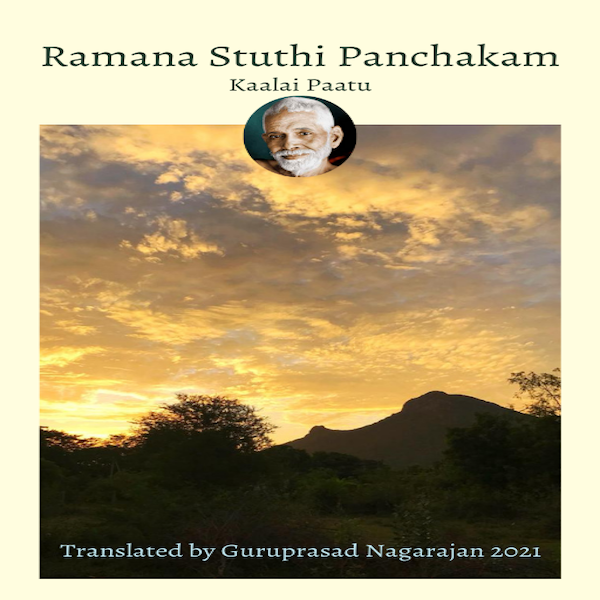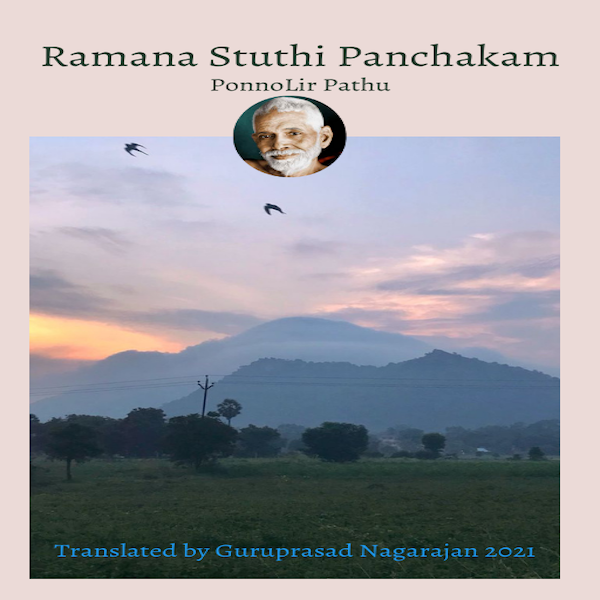MaNNu neerum vaLarndhezhu theyuvum
ViNNum kaalum nuzhaindhu viLangidum
ENNum sangayum ellayum indriya
KaNNuk kaavi RamNan en kaadhalan
Word meaning
maNN = earth; neer = water; theyu = fire; viNN = sky; kale = wind; eNNum = thought (too); nuzhaindhu = enter; sangai = doubt; ellai = boundary.
Ramana pervades the five elements of earth, water, fire, wind and space (sky). He is beyond all doubts and thoughts, he is dearest to me, he is my love.
Life form is composed of the five elements, and when it ends, the form goes back and dissolves into the elements. What was created on earth goes back to the earth completing the cycle. Bhagavan, who is both form and formless, is all the elements and at the same time transcends them all. Once when a devotee asked about god and his forms, Bhagavan said ‘First find out if you have form’. As we saw earlier, Yogi Ramaiah had darshan of Rama in Bhagavan and also as formlessness.
To those who surrender to the feet of Bhagavan, he is the Truth untainted by earth-bound ideas such as thoughts and doubts. Because thoughts and doubts occur to the mind-body consciousness, not to the Self. As Bhagavan said once, ‘I am where there are words’. Words stem from thoughts and thoughts from ‘I am the mind-body’ idea. In the pure space beyond these limitations set by ignorance, is Bhagavan, full of love and grace.
SV calls Bhagavan ‘my love’ (kaadhalan means male lover, kaadhali is female lover). It is quite common for poets to think of their beloved gods as their lovers. Bhagavan himself became a love-lorn lady in his akshsramana malai, beseeching her lover, Arunachala to merge with ‘her’ through 108 verses of pure bhakti and longing. Bharathiar, a 19th century poet, in his collection ‘KaNNan Paatu (Krishna song) has imagined Lord Krishna as his lover (both female and male forms), friend, father, mothering, disciple, servant, baby, playmate and sadguru. In another variation, KaNNa becomes KaNNamma, a female version of the lord. By bringing the Absolute on to his own mortal level, the poet takes the liberty to treat his object of admiration and love as he would a regular mortal in a display of mortal love and affection and other human emotions.
ViNNum kaalum nuzhaindhu viLangidum
ENNum sangayum ellayum indriya
KaNNuk kaavi RamNan en kaadhalan
Word meaning
maNN = earth; neer = water; theyu = fire; viNN = sky; kale = wind; eNNum = thought (too); nuzhaindhu = enter; sangai = doubt; ellai = boundary.
Ramana pervades the five elements of earth, water, fire, wind and space (sky). He is beyond all doubts and thoughts, he is dearest to me, he is my love.
Life form is composed of the five elements, and when it ends, the form goes back and dissolves into the elements. What was created on earth goes back to the earth completing the cycle. Bhagavan, who is both form and formless, is all the elements and at the same time transcends them all. Once when a devotee asked about god and his forms, Bhagavan said ‘First find out if you have form’. As we saw earlier, Yogi Ramaiah had darshan of Rama in Bhagavan and also as formlessness.
To those who surrender to the feet of Bhagavan, he is the Truth untainted by earth-bound ideas such as thoughts and doubts. Because thoughts and doubts occur to the mind-body consciousness, not to the Self. As Bhagavan said once, ‘I am where there are words’. Words stem from thoughts and thoughts from ‘I am the mind-body’ idea. In the pure space beyond these limitations set by ignorance, is Bhagavan, full of love and grace.
SV calls Bhagavan ‘my love’ (kaadhalan means male lover, kaadhali is female lover). It is quite common for poets to think of their beloved gods as their lovers. Bhagavan himself became a love-lorn lady in his akshsramana malai, beseeching her lover, Arunachala to merge with ‘her’ through 108 verses of pure bhakti and longing. Bharathiar, a 19th century poet, in his collection ‘KaNNan Paatu (Krishna song) has imagined Lord Krishna as his lover (both female and male forms), friend, father, mothering, disciple, servant, baby, playmate and sadguru. In another variation, KaNNa becomes KaNNamma, a female version of the lord. By bringing the Absolute on to his own mortal level, the poet takes the liberty to treat his object of admiration and love as he would a regular mortal in a display of mortal love and affection and other human emotions.







 RSS Feed
RSS Feed